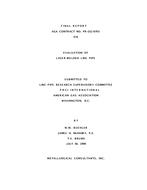Provide PDF Format
PRCI PR-276-04502
- Failure Initiation Modes of Pipe with High Charpy Transition Temperature
- Report / Survey by Pipeline Research Council International, 01/01/2004
- Publisher: PRCI
$6.00$12.00
L52249e
Engineering Mechanics Corporation of Columbus (EMC2)
Need: This project was developed to establish a general methodology to; (a) determine a simple way to assess what is the lowest temperature where ductile crack initiation will occur for a sharp crack or a blunt flaw (i.e., corrosion), (b) to developed several optional approaches to predict the transition temperature shifts that depend on what type of lab specimen data are available, and (c) show validation from past tests as well as by conducting tests on older vintage linepipe steels.
Result: This report presents a methodology that determines the lowest temperature where ductile fracture would occur for either a sharp cracks or blunt corrosion flaws in older low-toughness linepipe base metals. It is applicable to either axial or circumferential flaws in pipes under quasi-static loading, i.e., normal operating conditions with no sudden transient loads. The results showed that ductile initiation of a surface crack can occur at a significantly lower temperature than the Charpy transition temperature. A master curve of transition temperatures for different pipe thickness and crack geometries was developed and validated on 1927 and 1948 vintage pipes. The master-curve of transition temperatures comes from accounting for thickness effects, loading-rate effects, and constraint effects (for a surface crack) on the transition temperatures of the flawed pipe relative to the Charpy transition temperature. These transition temperature shifts were empirically determined from hundreds of past full-scale tests and literally thousands of laboratory tests, and then checked against data developed on much older vintage linepipe steels, i.e., the 1927 and 1948 pipes in this project.
Benefit: The initial work on sharp cracks on pipes was presented in a paper for nuclear ferritic pipe application at the 2005 ASME PVP conference. This project builds on that work by conducting addition tests on sharp cracks in two older linepipe materials, as well also investigating the effects of corrosion flaws with different radius of curvature. These results show that there is another transition temperature shift from the sharp crack to a blunt corrosion flaw. The benefit of this work is to assess the lowest temperatures where a sharp or blunt flaw will have failure pressures that still correspond to upper-shelf behavior. If the initiation transition temperature is low enough, then perhaps corrosion flaws even in older pipes with very high transition temperatures could always be assessed by limit-load solutions like the RSTRENG analysis.
Engineering Mechanics Corporation of Columbus (EMC2)
Need: This project was developed to establish a general methodology to; (a) determine a simple way to assess what is the lowest temperature where ductile crack initiation will occur for a sharp crack or a blunt flaw (i.e., corrosion), (b) to developed several optional approaches to predict the transition temperature shifts that depend on what type of lab specimen data are available, and (c) show validation from past tests as well as by conducting tests on older vintage linepipe steels.
Result: This report presents a methodology that determines the lowest temperature where ductile fracture would occur for either a sharp cracks or blunt corrosion flaws in older low-toughness linepipe base metals. It is applicable to either axial or circumferential flaws in pipes under quasi-static loading, i.e., normal operating conditions with no sudden transient loads. The results showed that ductile initiation of a surface crack can occur at a significantly lower temperature than the Charpy transition temperature. A master curve of transition temperatures for different pipe thickness and crack geometries was developed and validated on 1927 and 1948 vintage pipes. The master-curve of transition temperatures comes from accounting for thickness effects, loading-rate effects, and constraint effects (for a surface crack) on the transition temperatures of the flawed pipe relative to the Charpy transition temperature. These transition temperature shifts were empirically determined from hundreds of past full-scale tests and literally thousands of laboratory tests, and then checked against data developed on much older vintage linepipe steels, i.e., the 1927 and 1948 pipes in this project.
Benefit: The initial work on sharp cracks on pipes was presented in a paper for nuclear ferritic pipe application at the 2005 ASME PVP conference. This project builds on that work by conducting addition tests on sharp cracks in two older linepipe materials, as well also investigating the effects of corrosion flaws with different radius of curvature. These results show that there is another transition temperature shift from the sharp crack to a blunt corrosion flaw. The benefit of this work is to assess the lowest temperatures where a sharp or blunt flaw will have failure pressures that still correspond to upper-shelf behavior. If the initiation transition temperature is low enough, then perhaps corrosion flaws even in older pipes with very high transition temperatures could always be assessed by limit-load solutions like the RSTRENG analysis.
Related Products
PRCI PR-276-0290
Calibration of the PRCI Thermal Model for Hot Tap Welding Using Weld Data..
$6.00 $12.00
PRCI Monograph 8
Gas Hydrates and Their Relation to the Operation of Natural-Gas Pipe Lines..
$6.00 $12.00



